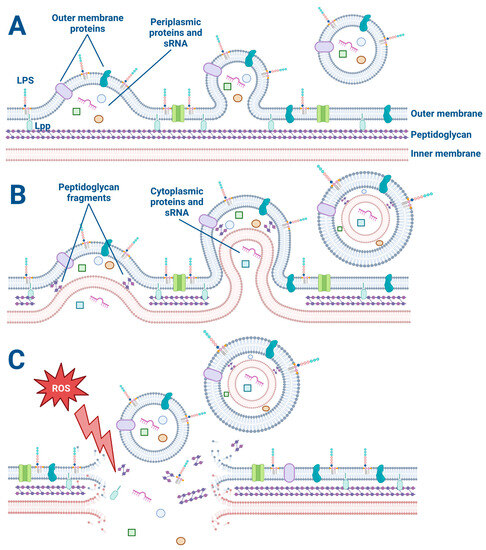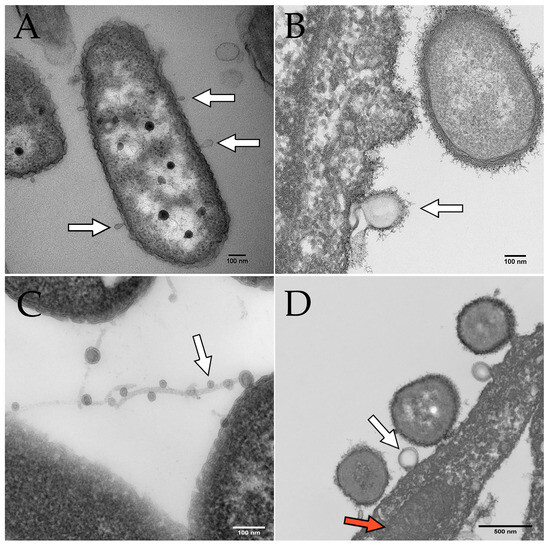You're using an outdated browser. Please upgrade to a modern browser for the best experience.
Please note this is a comparison between Version 1 by Lily Charpentier and Version 2 by Sirius Huang.
Outer membrane vesicles (OMVs) are spheroidal proteoliposomes ranging from ~20 to 200 nm in diameter that originate from the outer membrane of Gram-negative bacteria. The biogenesis of OMVs has been a topic of intense research due to the diverse roles that OMVs play in bacterial pathogenesis, immune modulation, and potential therapeutic applications.
- outer membrane vesicles (OMVs)
- DNA methylation (DNAm)
- immune modulation
1. Introduction
Gram-negative bacteria employ diverse mechanisms to interact with other bacteria and their human hosts. Among these mechanisms, outer membrane vesicles (OMVs) are critical in facilitating host–pathogen interactions without requiring direct cell-to-cell contact. This is particularly relevant when bacteria colonize the mucus that overlays host epithelial cells [1][2][1,2]. OMVs are spheroidal proteoliposomes ranging from ~20 to 200 nm in diameter that originate from the outer membrane of Gram-negative bacteria [3][4][5][6][3,4,5,6]. These vesicles contain various cytoplasmic and periplasmic components, including proteins, DNA, RNA, and metabolites [7][8][9][10][7,8,9,10]. The lipid bilayer of OMVs protects the contents from extra-vesicular proteins, such as proteases and RNases [2]. OMVs were first characterized in 1967 by Chatterjee and Das by transmission-electron microscopy of Vibrio cholerae [11]. Studies in the years since have shown that OMVs are produced by a diverse range of Gram-negative bacteria during infection and have been isolated from both pathogenic and commensal bacteria colonizing the human gut and lung. Although Gram-negative bacteria also release outer-inner membrane vesicles (O-IMVs) that derive from the bacterium’s inner and outer membrane, these vesicles account for less than 1% of the total secreted vesicles [12]. Both OMVs and O-IMVs encapsulate bacterial factors that modulate the host’s immune response to infection. These factors include proteins that inhibit epithelial chloride ion secretion and small interfering RNA (sRNA) that bind to and silence host mRNA transcripts. Despite the significant progress that has been made in characterizing the immunomodulatory properties of OMVs, many of their mechanisms of action remain elusive. Therefore, investigating the interplay between host and OMVs is crucial for developing novel therapies against bacterial infections and the ensuing inflammatory response. Recent reviews explore the intricate interactions between OMVs and the host immune response [13][14][15][16][17][18][19][20][21][13,14,15,16,17,18,19,20,21].
2. OMV Biogenesis
The biogenesis of OMVs has been a topic of intense research in recent years due to the diverse roles that OMVs play in bacterial pathogenesis, immune modulation, and potential therapeutic applications. The explosive cell lysis and budding models are two proposed mechanisms for OMV generation in Gram-negative bacteria (Figure 1).
Figure 1. The explosive cell lysis and budding models of OMV and O-IMV generation. (A) The budding mechanism of OMV generation. Lipoproteins (Lpp) anchor the outer membrane to the peptidoglycan. Membrane proteins and lipopolysaccharides (LPS) decorate the outer membrane and are incorporated into the budding OMV along with periplasmic proteins and sRNA. (B) The budding model of O-IMV generation. Both cytoplasmic and periplasmic proteins and sRNA are incorporated into budding O-IMVs. (C) Cellular stress such as exposure to reactive oxygen species disrupts the membrane of a Gram-negative bacterium, causing membrane fragments to encapsulate free periplasmic and cytoplasmic material and form OMVs and O-IMVs.

Figure 2. Electron microscopy images of OMVs budding from P. aeruginosa. Scale bars indicate 100 nm in panels (A–C) and 500 nm in panel (D). White arrows indicate OMVs in all panels. (A) OMVs budding from P. aeruginosa PAO1 cultured on human bronchial epithelial cells. (B) OMV budding from P. aeruginosa PA14 grown in Minimal Essential Medium (MEM) with 0.4% arginine. (C) OMVs on filamentous structures produced by P. aeruginosa. (D) P. aeruginosa OMV (derived from PAO1 grown in MEM with 10 mM glucose and 8 µM FeCl3) fusing with a eukaryotic cell. The red arrow indicates a mitochondrion in the airway epithelial cell.
